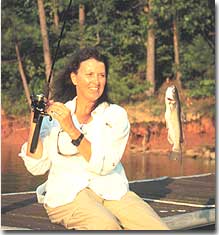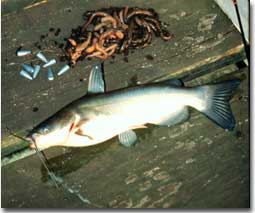Lake Lanier's Other Catfish
Lake Lanier's Other Catfish
By Bill Vanderford
 Though not as well-known or popular as its cousin the channel catfish, the white catfish has always been a favorite of those who like to sit along a shoreline and fish lazily. This is because the white catfish generally prefers slower-moving water than many others in the catfish family. In fact, they are predominantly found in lakes, ponds, meandering rivers or streams, and eddy-type backwaters of faster rivers.
Though not as well-known or popular as its cousin the channel catfish, the white catfish has always been a favorite of those who like to sit along a shoreline and fish lazily. This is because the white catfish generally prefers slower-moving water than many others in the catfish family. In fact, they are predominantly found in lakes, ponds, meandering rivers or streams, and eddy-type backwaters of faster rivers.
Despite the lack of spots along the sides of their body or a deeply pointed and forked tail, white catfish are often mistaken for channel catfish due to the overall similar appearance and characteristics. White cats normally exhibit gray-blue to bluish-black on the upper part of the body, but the lower half of the body sometimes abruptly changes to the always white of its belly.
When the first settlers started catching white catfish, their habitat was confined to fresh or brackish water sections of coastal rivers along the Atlantic coast from New York’s Hudson River to Florida, and in tributaries of the Gulf of Mexico from Florida to Texas. Because of extensive restocking, however, the white catfish’s range has been expanded greatly in the northeast, southeast, and west, including California and Oregon.
White catfish are capable of surviving in waters that contain more silt and a higher salinity than other members of the catfish clan. Historically, white catfish spawn during late spring or early summer when water temperatures are in the seventy to eighty degree range.
 Because of a much slower growth rate than that of other catfish species, white catfish are normally three to four years of age and seven to nine inches in length before they spawn. A twelve inch female white cat can lay nearly four-thousand eggs that adhere to the bottom of the nest and hatch in approximately seven days at eighty degrees.
Because of a much slower growth rate than that of other catfish species, white catfish are normally three to four years of age and seven to nine inches in length before they spawn. A twelve inch female white cat can lay nearly four-thousand eggs that adhere to the bottom of the nest and hatch in approximately seven days at eighty degrees.
The main diet of white catfish consists of aquatic insects, crustaceans, worms, and smaller fish. Nevertheless, this member of the catfish clan will also eat aquatic plants or human food that is thrown into their watery home. Therefore, white cats are usually easier than some other species to catch.
Sport fishermen can apply numerous methods to both attract and catch plenty of white catfish. These cats don’t move far from the area where they were born except at spawning time, so it’s usually fairly simple to entice them. This can be accomplished by chumming the waters with fish or worms cut into small bites that are scattered around the spot to be fished a day or two earlier. In lieu of the fish or worms, one may substitute dog or cat food. Any of these will attract white catfish to the intended fishing area and hold their interest for a few days. This method works even better in a stream or river because the smell from the bait is carried farther downstream by the current.
Even without chumming, white catfish are normally easy to attract with a number of different baits. Probably the best overall bait is the Canadian nightcrawler, but chunks of beef, pork, lamb, fish, and poultry are quite productive. Catfish especially like portions of the heart, liver, gizzard and lungs of any animal. In brackish water areas, clams, and mussels are an excellent bait when opened first and heated by the sun. Additionally, many prepared baits are on the market that can be purchased at most fishing or bait stores. Even soap, cheese, or congealed chicken blood can be utilized to attract white cats.
Like most other catfish species, white cats are caught more easily during the hours of darkness, unless the water is fairly stained from heavy rains. During those conditions, even the middle of the day can be great.
Since white catfish are generally smaller than other catfish species, lighter tackle is needed. Cane poles are great, but medium to light spincast or open-faced spinning reels are more efficient, and bottom rigs of one kind or another seem to work best since white catfish feed primarily on or near the bottom.The best months to catch them are from May to November.
One of the best parts of catching white catfish is preparing and eating this tasty member of the catfish family. They possess a firm, white meat that is excellent tablefare when fried golden brown in a big iron skillet, especially over a campfire on a starry night.
Though its bewhiskered countenance is not one of the most beautiful sights in American waters, the white catfish is certainly one of the most prolific fishes, and relatively easy for anyone to catch. Despite its homely appearance, "Old Whiskers" is an excellent adversary on a rod and reel, and one of the best eating fish that swims!
|
